During an online wasp identification course I participated in several weeks ago, there was a fun discussion about whether commercially-produced figs contained fig wasps (Agaonidae, in the Chalcidoidea). Opinions varied, plus some asserted, as do many internet pages, that even if wasps were once inside the figs that ficain (an enzyme) would completely dissolve their bodies. So I purchased a bag of figs and had a look. I found a wasp in the very first fig, in approximately two seconds. And I found much more than that. Photographic details below.
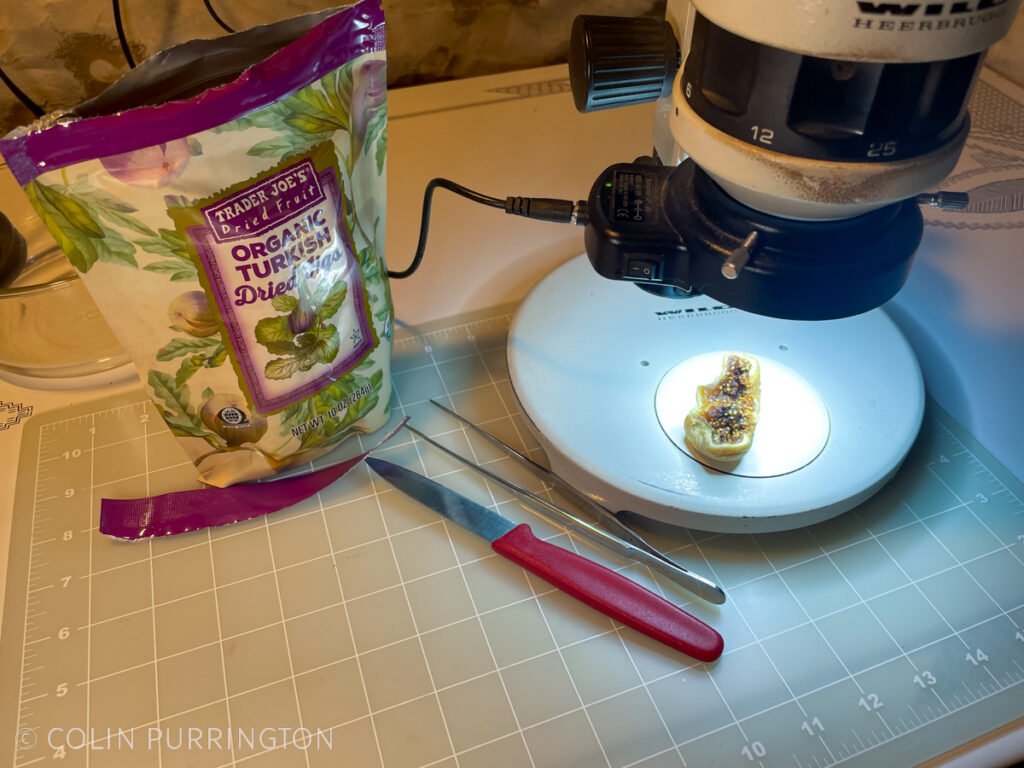
The wasp was small, like most wasps, so here’s a photograph with an arrow pointing out the position. It was wedged in between some of the involucral bracts just inside the ostiole (opening) of the syconium (the “fruit” that is actually an inverted infructescence). I’m not sure whether the wasp was going in or going out.
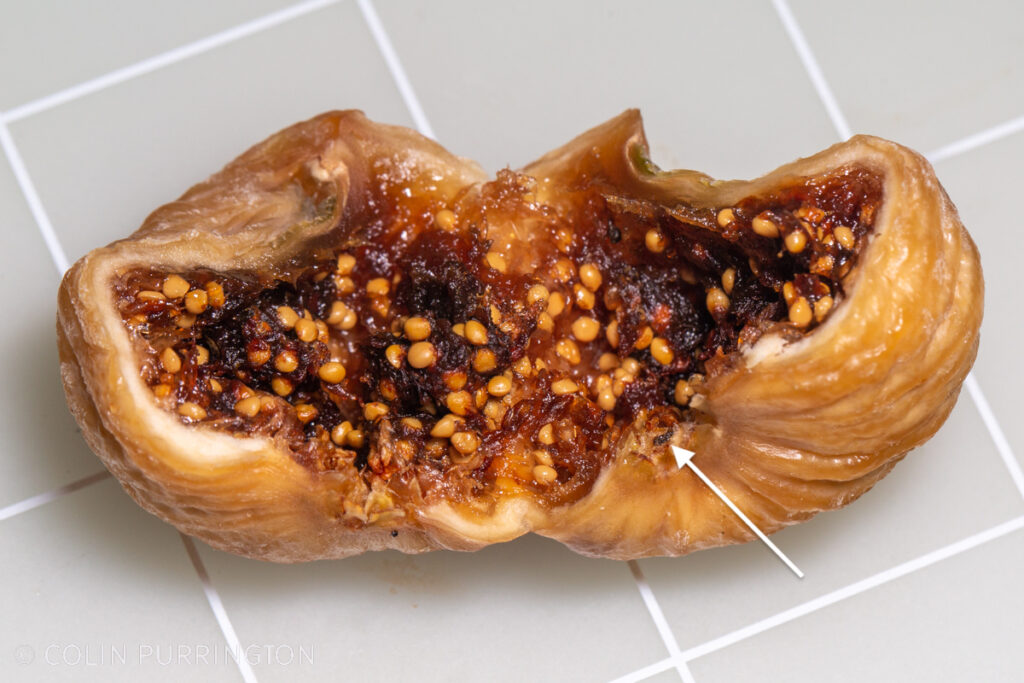
Here’s a close-up of the wasp, or at least what’s left of it. The shape and positions of the legs seem to be a good match for Blastophaga psenes, the sole pollinator (I think) of Ficus carica. In particular, the middle femorae are much smaller than the front and hind femorae. And the head is wedge-shaped, another attribute of the family.
The species exists in Turkey and in many other places where figs are grown. E.g., it’s in California because it was deliberately introduced there in 1899. This means, of course, that figs grown in California may have wasps in them, too. I’m just the messenger.
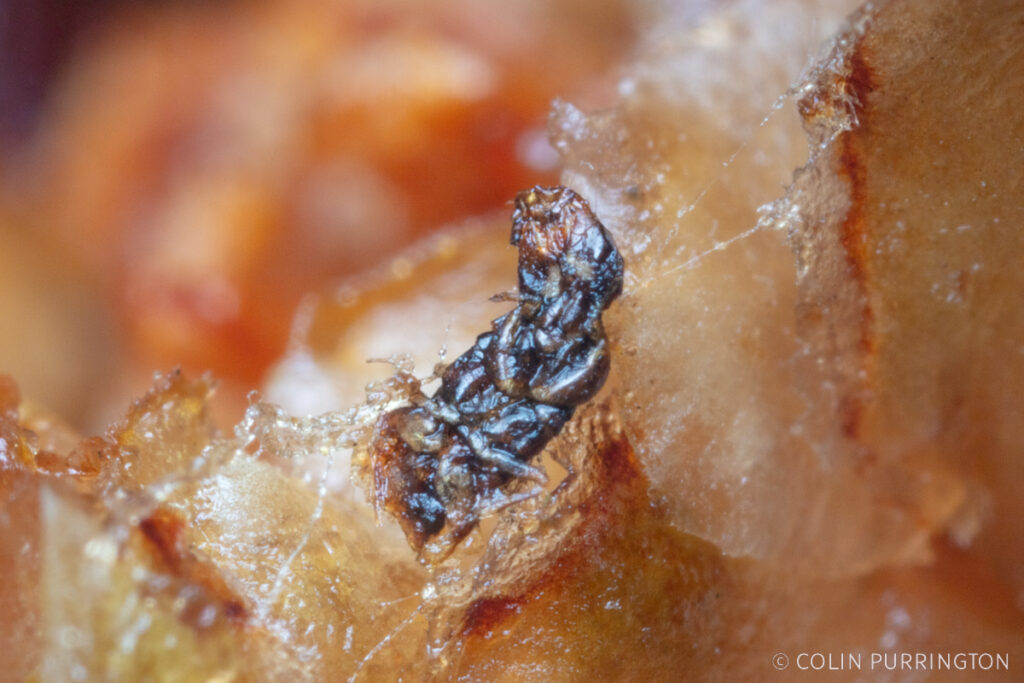
Below is the dorsal side showing (I think) the quadrate scutellum, another family characteristic. The antennae appear to be folded medially into a streamlined position that I assume is useful for navigating the bract maze. I have more pics on iNaturalist.
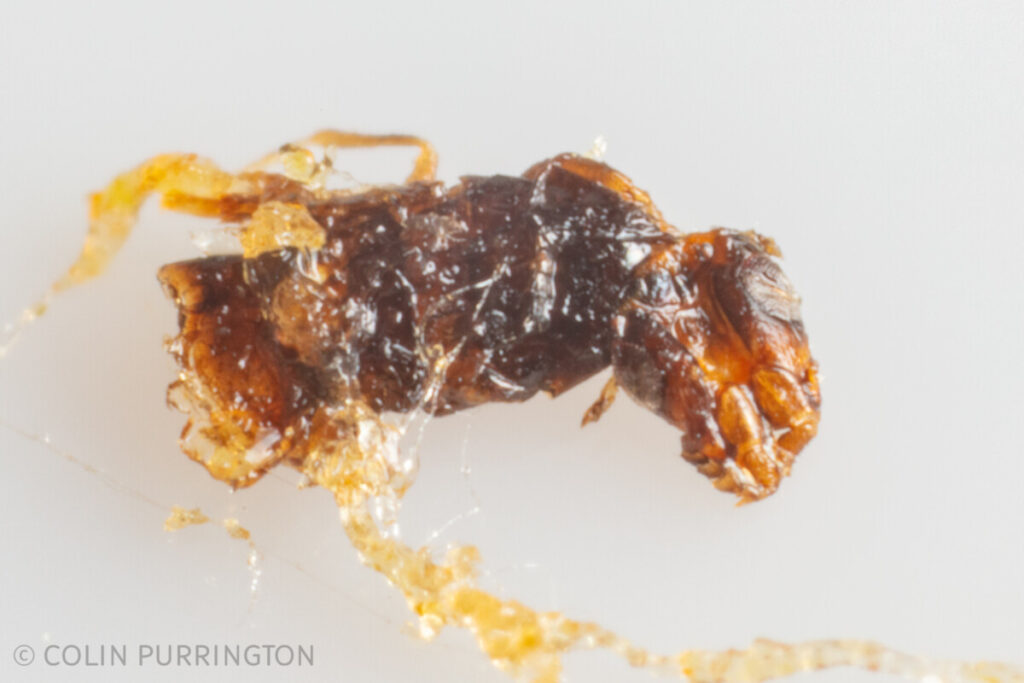
In a different fig, I found two more wasps of a second species. I don’t have a high confidence in my identification but I think they might be Habrobracon hebetor (Braconidae). This species is a regular inside stored figs because it parasitizes caterpillars that eat dried fruit. This wasp, I’m guessing, oviposited into caterpillar-infested figs after they arrived in California (where Trader Joe’s presumably has a warehouse). I don’t know whether the species occurs in Turkey. I have more pics on iNaturalist.

Below is a caterpillar in the same fig as the wasp above. Caterpillars were present in several other figs, too, and they were often accompanied by fungal growth. I don’t have an identification guess but if you recognize it please visit my iNaturalist observation.
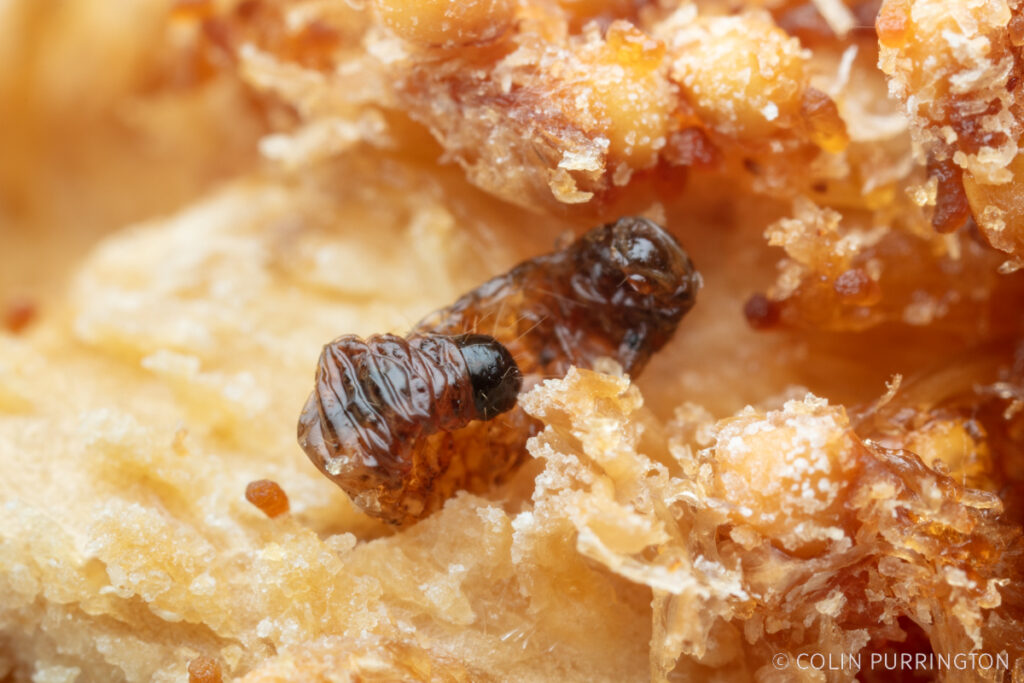
I’m not sure whether it’s a different species, but the cocoons below seem to be lepidopterans, too. Here is the iNaturalist link.
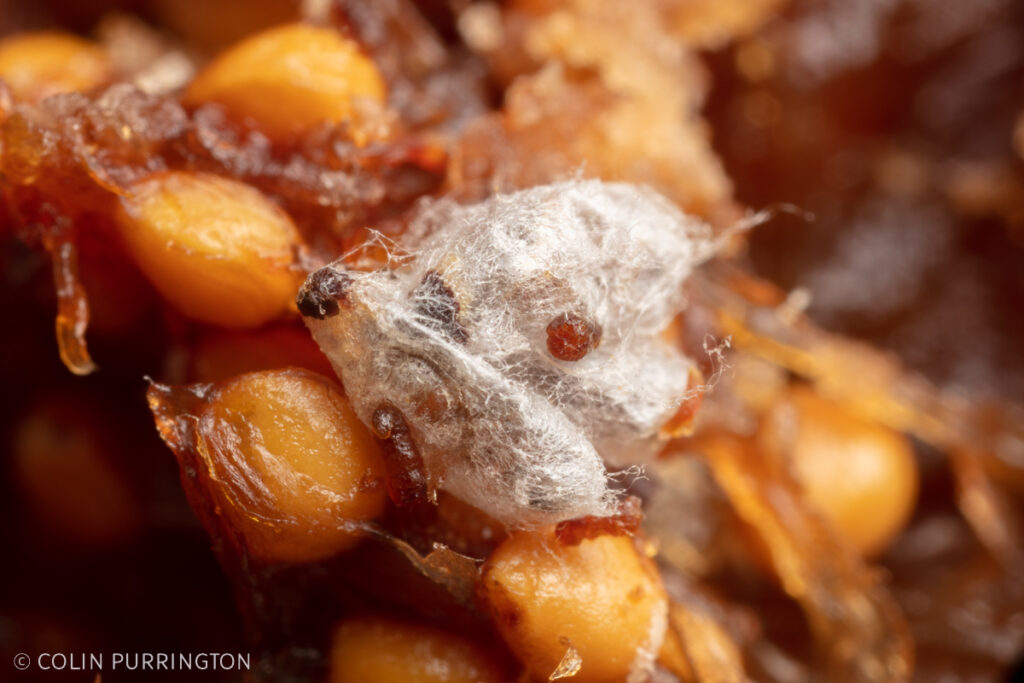
Here’s the final type of lepidopteran I found, a pupa. Again, I’m not sure what family it might be in. Here’s the iNaturalist listing. The photograph also shows a good quantity of frass, something I found in many of the figs even when I couldn’t locate a caterpillar. The dark color on the left is from fungal growth.
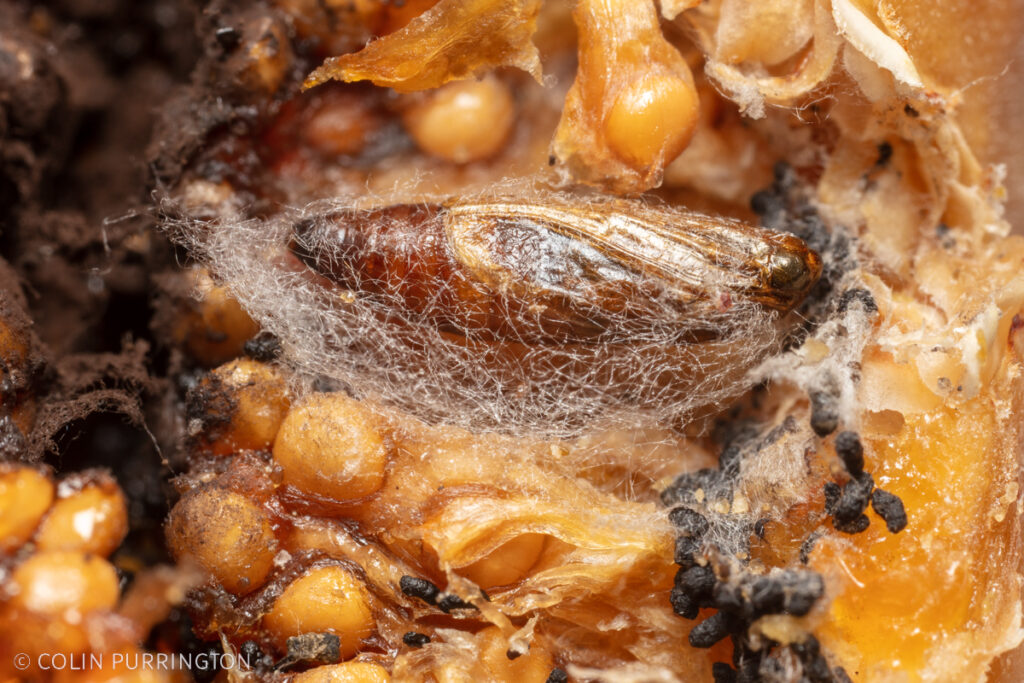
The final insect that turned up is a beetle, which I think might be Carpophilus hemipterus, a species native to Asia but now pretty much everywhere. It’s definitely in California. Here’s my iNaturalist observation if you’d like to weigh in on the identification.

I’d like to point out that insects are extremely common in stored food so the above doesn’t come as a huge surprise to me. And the figs were clearly labelled “organic”, a term that to me greatly boosts the likelihood that there are organisms inside. Unless you have an allergy to chitin or some other insect component (it happens), inadvertent consumption of arthropods isn’t going to harm you.
What did surprise me was how common fungal growth was in this bag of figs. Below is a photograph of what the fungus usually looked like. Not sure what it is (Aspergillus niger?). Some of them were mildly lit up by 356nm UV light, by the way. I think that’s a bad sign.
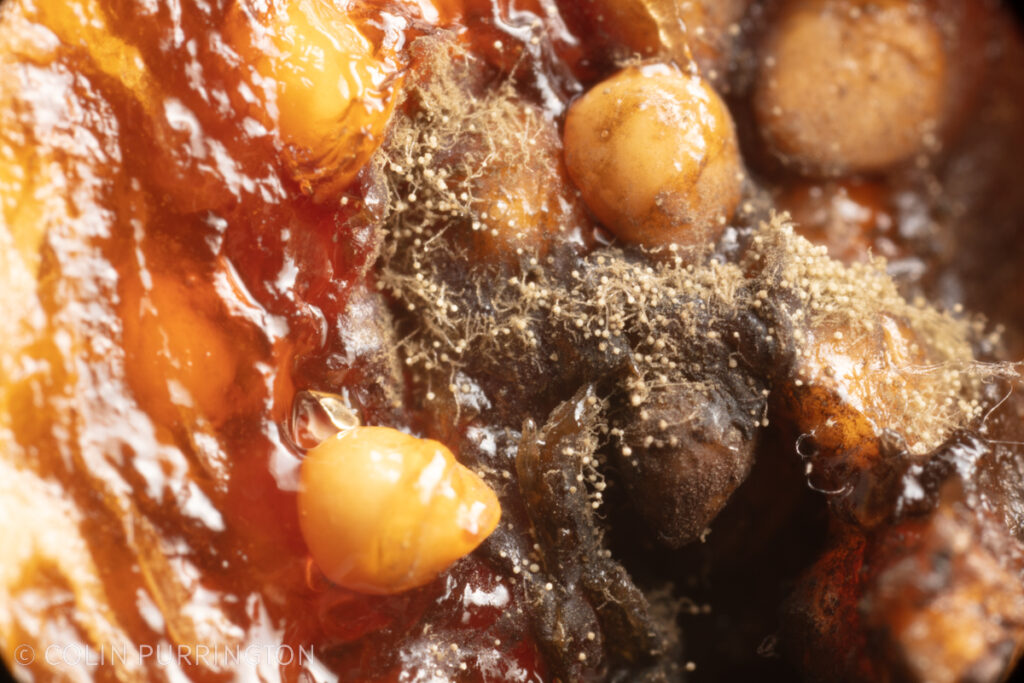
But a little research turned up what might be the obvious explanation: wasps that manage to crawl into figs via ostiole can be covered with fungal spores in the same way that they are often covered with pollen (that’s the whole point of fig wasps). Indeed, some fig farmers regularly spray anti-fungals onto figs before the females emerge to prevent them from picking up spores and transmitting them to the next fig. Without such treatment (i.e., at organic farms), it’s not rare to find smuts (Aspergillus spp.), endosepsis (Fusarium spp.), and Alternaria rot. Aside from potentially changing the taste of dried figs, I guess there’s a chance you could get a dose of aflatoxins. There’s research on the issue, even articles on the risk from dried Turkish figs.
When fresh figs start to arrive from California I might sacrifice some for a similar investigation. I’d love to find a fig wasp in better condition so I can photograph it. They are bizarre. But per several sources, many (most?) of the figs in California are produced by plants that don’t need fertilization, so finding one might be a challenge. Still, because fig wasps are naturalized in California, I wouldn’t be surprised if they’d still show up inside those varieties. As a demonstration that wasps are alive and well in California, you can order wasp-laden figs online at FigBid.com (e.g., this listing). Note that you don’t order such figs for eating. They are for placing near your crop of figs so that they can get pollinated. Some of the most delicious varieties of figs need such pollination. And some of the varieties that don’t need figs still develop much tastier fruit when they are pollinated by wasps.
Here’s what the California Fig Advisory Board has to say,
“https://californiafigs.com/faq/#:~:text=I%E2%80%99ve%20heard%20that%20there%20are%20wasps%20in%20figs.%20Is%20this%20true%3F
Next on my to-do list is to find the coffee berry borer (Hypothenemus hampei).
Resources
- Gods, Wasps and Stranglers (a fantastic book)
- “Are there wasps in my Newtons?” (a fantastic blog)
- “Are figs really full of baby wasps?“
- “Fig in California“
- “A wasp works wonders for Smyrna figs“
- “I’ve heard that there are wasps in figs. Is this true?” (CA Fig Advisory Board)

